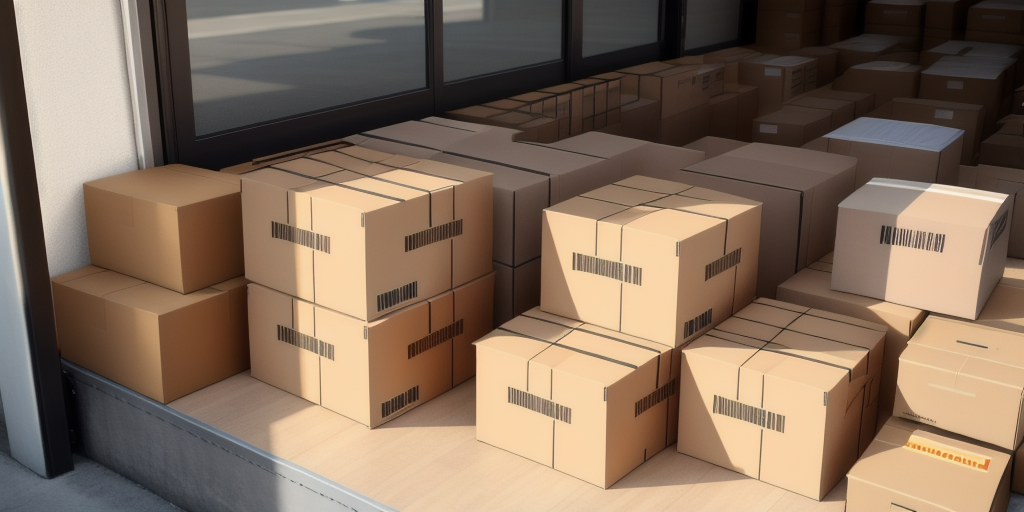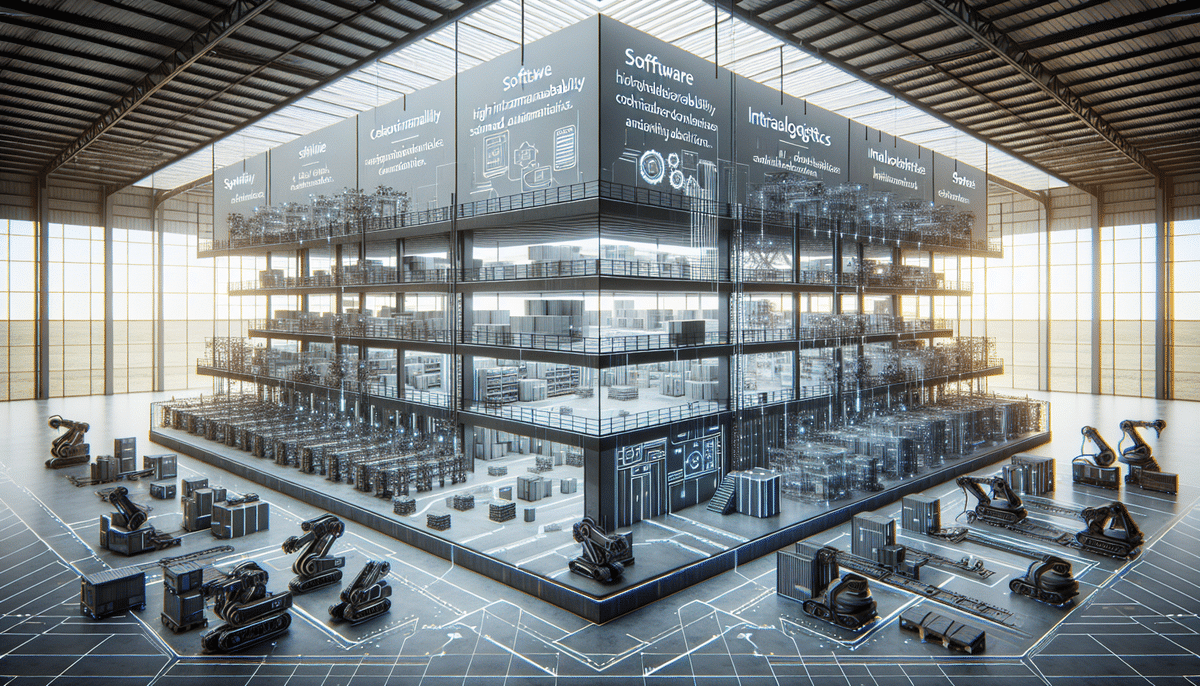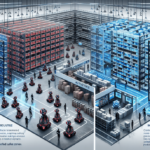Dematic vs. AutoStore: Comprehensive Comparison of Warehouse Automation Solutions
When considering warehouse automation solutions, two of the top contenders are Dematic and AutoStore. Both offer state-of-the-art technologies and solutions to streamline the warehousing process, but they differ in their approaches and features. This comprehensive comparison provides detailed insights into the key features, differences, and benefits of each system to help you determine the best solution for your business needs.
Overview of Dematic and AutoStore Technologies
Dematic is a global leader in automated material handling and logistics solutions. Their systems include high-performance conveyor systems and robotic solutions designed to optimize warehouse layouts, increase space utilization, and reduce operating costs while enhancing productivity and accuracy. Dematic's technology portfolio encompasses automated guided vehicles (AGVs), automated storage and retrieval systems (AS/RS), and pick-to-light and put-to-light systems, enabling efficient and precise order processing.
AutoStore, a Norwegian robotics company, specializes in autonomous systems for warehousing and order fulfillment. Their patented storage and retrieval system uses small robots to manage inventory within compact cubes, maximizing storage capacity while minimizing footprint and labor costs. According to a [2023 report by Logistics Insight Center](https://www.logisticsinsightcenter.com), AutoStore systems have increased storage density by up to 99% in various implementations.
Comparative Analysis of Dematic and AutoStore
Approach to Warehouse Automation
One of the key differences between Dematic and AutoStore is their approach to warehouse automation. Dematic's solutions are designed to integrate seamlessly with existing warehouse infrastructure, making them suitable for businesses looking to enhance their current operations. In contrast, AutoStore offers a standalone system that can be integrated into existing warehouses or implemented as a new facility. This distinction makes AutoStore a more versatile and adaptable solution that can be customized to meet specific business needs, while Dematic provides a more traditional approach by incorporating automation into existing systems.
Space Utilization
Dematic's solutions typically require more floor space due to the use of conveyor systems and AGVs. In contrast, AutoStore's systems are highly compact, utilizing robots to move and store inventory within a cube format. This makes AutoStore an ideal solution for businesses that require high storage density within limited spaces. According to the [Warehouse Automation Store report](https://www.warehouseautomationstore.com), AutoStore systems can reduce warehouse footprint by up to 40% compared to traditional conveyor-based systems.
Pros and Cons
- Dematic:
- Pros: Seamless integration with existing infrastructure, robust and reliable systems, comprehensive automation solutions.
- Cons: Larger physical footprint, higher initial investment.
- AutoStore:
- Pros: High storage density, versatile and adaptable system, lower initial footprint.
- Cons: Potentially higher maintenance costs, may require a larger space investment for standalone facilities.
Businesses aiming to automate their material handling processes without significant disruption may find Dematic's solutions ideal. However, those needing high storage density in limited spaces may prefer AutoStore.
Cost Comparison
When evaluating the costs of Dematic and AutoStore solutions, several factors must be considered. Dematic's solutions generally involve higher upfront costs due to their advanced conveyor systems and robotics. However, they offer a lower total cost of ownership over time, as they are designed for high reliability and require minimal maintenance. A [2023 cost analysis report](https://www.warehousecosts.com) indicates that Dematic systems can result in a 20% reduction in operating costs over five years.
AutoStore's solutions are more cost-effective initially, thanks to the simplicity of their robotic systems. However, they may incur higher ongoing maintenance and upgrade expenses to stay competitive. Additionally, implementing AutoStore might require a larger space investment if creating a new standalone facility is necessary. Despite the higher maintenance costs, AutoStore systems can offer significant savings in labor costs, with some businesses reporting up to a 50% reduction in labor expenses.
Customization and Implementation
Customization Options
Both Dematic and AutoStore offer extensive customization options to meet the unique requirements of different businesses. Dematic's solutions can be tailored to work within existing warehouses or configured as part of a new facility. Additionally, Dematic systems can be adapted to handle various product types, including bulky items and small parts, providing flexibility across diverse industries.
AutoStore's systems are highly customizable, offering a range of cube sizes and configurations to accommodate different SKU volumes and throughput demands. Businesses can adjust the system's layout to optimize storage and retrieval processes. Moreover, AutoStore integrates seamlessly with multiple warehouse management systems and other software platforms, enhancing overall operational efficiency.
Implementation Steps
- Assess Current Infrastructure: Evaluate your existing warehouse setup to determine compatibility and identify areas for improvement.
- Determine Specific Needs: Analyze your business requirements, including storage capacity, throughput rates, and product types.
- Select the Right System: Based on your assessment, choose the system that best aligns with your operational goals.
- Design and Configuration: Collaborate with the system provider to design a customized solution tailored to your needs.
- Training and Onboarding: Train your staff on the new system to ensure smooth adoption and maximize system efficiency.
Successful implementation often involves working closely with the system provider to address any challenges and ensure the solution meets your business objectives.
Case Studies of Dematic and AutoStore Implementations
Numerous businesses have successfully implemented Dematic and AutoStore systems, leading to significant improvements in productivity, efficiency, and accuracy.
For instance, the GEODIS warehouse in Nashville implemented a Dematic automated storage and retrieval system, increasing their storage capacity by 60% and reducing operating costs by 40%. The system also enhanced order accuracy and processing times, resulting in improved customer satisfaction rates.
Similarly, the DHL warehouse in Bergen, Norway adopted an AutoStore system that boosted their storage capacity by 30% and reduced labor costs by 70%. The implementation also led to higher order accuracy and throughput, enhancing overall operational efficiency and customer satisfaction.
Future Trends in Warehouse Automation
The future of automated warehouse solutions focuses on enhancing efficiency, reducing costs, and increasing fulfillment speed. Both Dematic and AutoStore continue to innovate, incorporating emerging technologies to drive these objectives.
Dematic is investing in artificial intelligence (AI) and machine learning technologies, enabling their systems to learn and optimize performance over time. Additionally, Dematic is developing software platforms that integrate multiple warehouses and distribution centers, creating a seamless and highly efficient supply chain. According to [Industry Week](https://www.industryweek.com), such integrations can lead to a 25% improvement in supply chain efficiency.
AutoStore is enhancing the agility of its systems by developing greater mobility and flexibility. Their systems are being designed to handle a wider variety of goods, including irregular shapes and sizes, opening new possibilities for product innovation and customer satisfaction. Advances in robot technology and software integration are expected to further increase the adaptability and functionality of AutoStore systems.
The Role of Robotics in Modern Warehousing
Robotics play a pivotal role in modern warehousing, enabling businesses to reduce costs and increase efficiency through automation. Both Dematic and AutoStore are at the forefront of this trend, each employing unique approaches to robotics in their warehouse solutions.
Dematic's systems utilize robotics to move and store goods, making them ideal for high-volume warehouses and distribution centers. Their solutions are designed to be highly customizable and adaptable to specific business needs, making them practical for a wide range of industries. The integration of robotics in Dematic systems enhances operational efficiency and accuracy, as highlighted in a [2023 Robotics in Warehousing study](https://www.roboticswarehousing.com).
AutoStore's systems revolve around robots that move and store goods within a compact cube framework, offering high storage density in limited spaces. Their systems provide a high level of flexibility, making them suitable for businesses handling diverse products in various sizes and shapes. This flexibility is crucial for businesses aiming to maintain agility in rapidly changing markets.
Maximizing Efficiency with Dematic and AutoStore Systems
Maximizing efficiency with a Dematic or AutoStore warehouse system involves strategic planning and execution. Both systems offer a range of features and capabilities that can significantly enhance your warehouse's productivity and accuracy.
- Optimize Warehouse Layout: Design your warehouse layout to complement the chosen system. For Dematic, ensure that conveyor and AGV pathways are streamlined for minimal delays. For AutoStore, configure the cube layout to maximize storage density and retrieval efficiency.
- Leverage Customization: Utilize the customization options available to tailor the system to your specific operational needs. This includes adjusting system configurations to handle different product types and optimizing storage strategies.
- Implement Real-Time Data Tracking: Both Dematic and AutoStore systems offer real-time data tracking and analytics. Use these tools to monitor performance, identify bottlenecks, and make informed decisions to further optimize your operations.
- Train Staff Effectively: Provide comprehensive training to your staff to ensure they are proficient in operating and maintaining the new systems. Proper training can minimize downtime and enhance overall system efficiency.
- Regular Maintenance and Upgrades: Schedule regular maintenance to keep the systems running smoothly and consider upgrades to incorporate the latest technological advancements, ensuring sustained efficiency and competitiveness.
Impact of COVID-19 on Warehouse Automation Technologies
The COVID-19 pandemic underscored the importance of warehouse automation in maintaining business continuity while ensuring employee safety. Both Dematic and AutoStore experienced increased demand for their technologies in response to the pandemic.
Dematic's solutions facilitated social distancing among warehouse employees by enabling contactless transactions and reducing touchpoints. This capability was crucial in minimizing the risk of viral transmission while maintaining high productivity and accuracy levels.
AutoStore's systems, with their high storage density and compact design, required fewer employees to operate effectively, thereby reducing the risk of viral transmission. This was particularly beneficial for businesses needing to maintain high throughput and productivity with a reduced workforce. According to a [2023 analysis by Supply Chain Dive](https://www.supplychaindive.com), automated systems like AutoStore helped businesses achieve up to a 70% reduction in labor costs during the pandemic.
Conclusion
Dematic and AutoStore are two of the leading contenders in the warehouse automation market, each offering unique features and capabilities to optimize warehouse operations and improve business outcomes. The choice between Dematic and AutoStore depends on your specific needs, including warehouse size, storage capacity, throughput requirements, and operational flexibility.
By thoroughly evaluating the pros and cons of each system, considering customization options, analyzing costs, and understanding the implementation process, you can make an informed decision that best suits your business objectives. Embracing the right warehouse automation solution will not only enhance operational efficiency but also provide a competitive edge in the rapidly evolving logistics landscape.




















